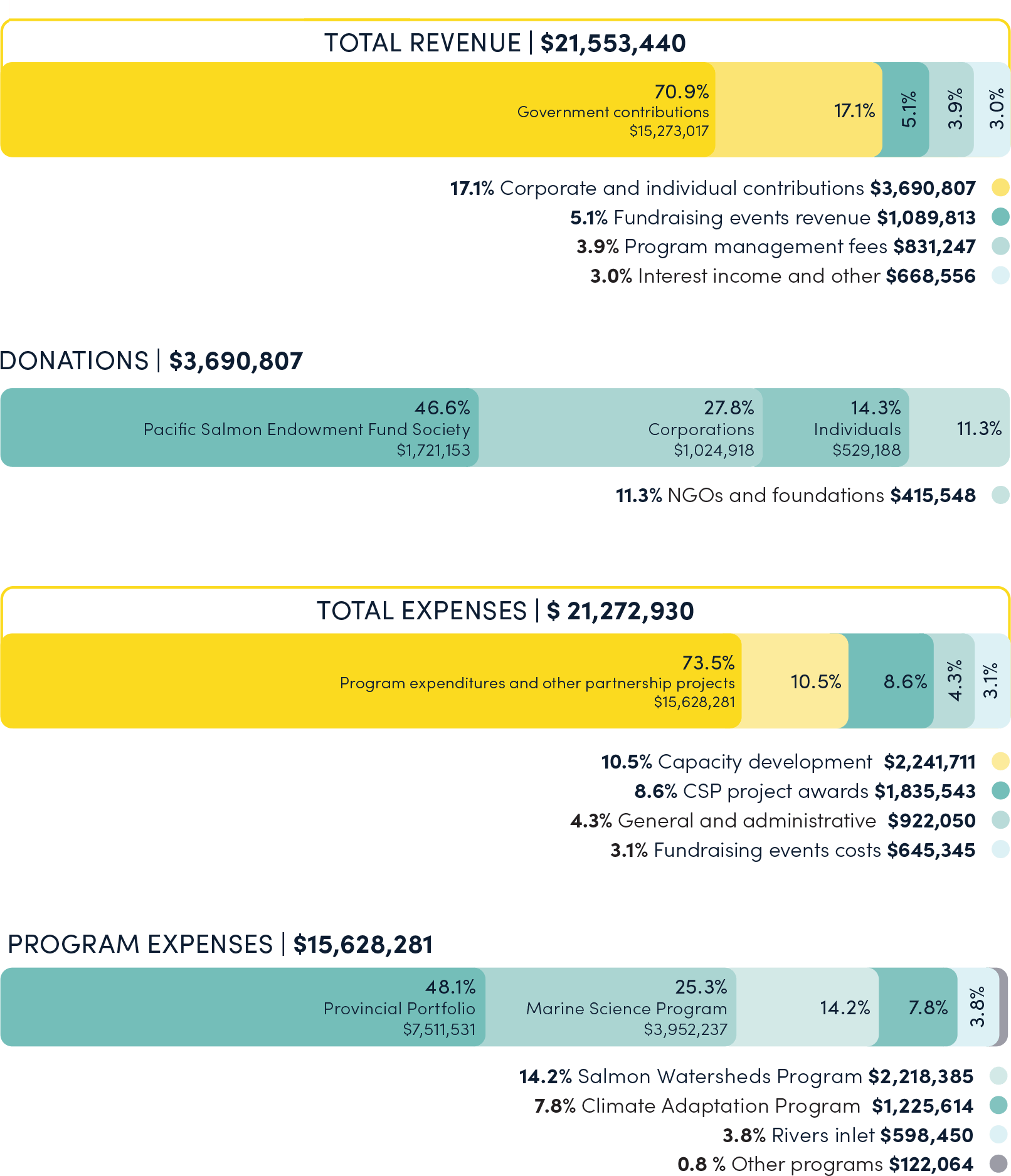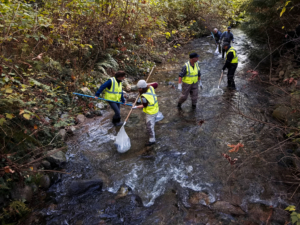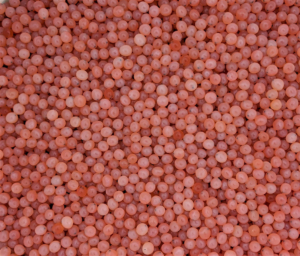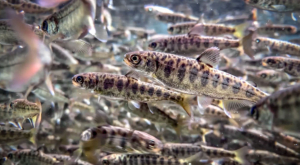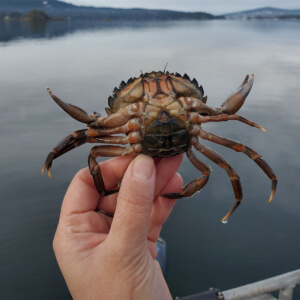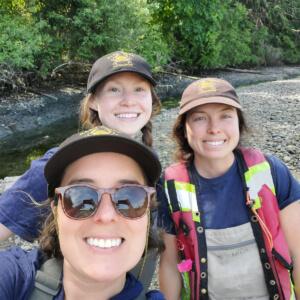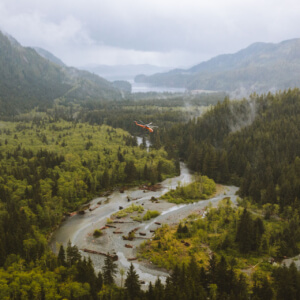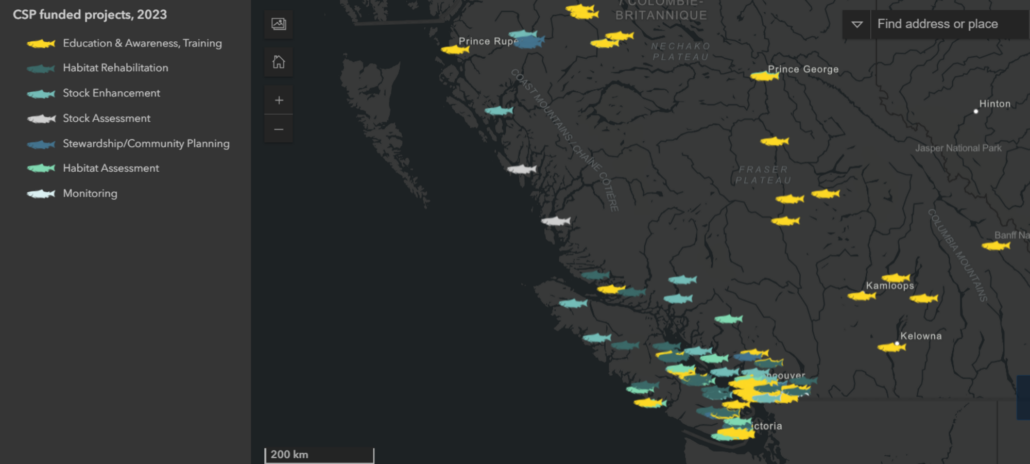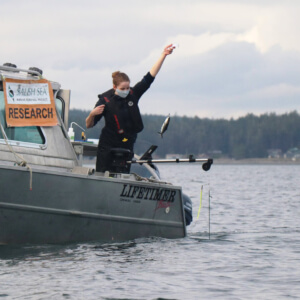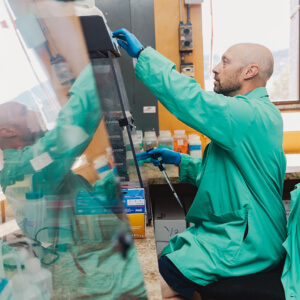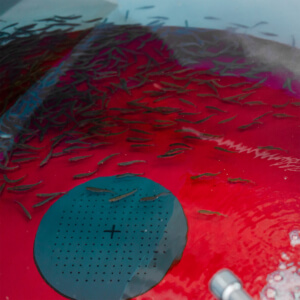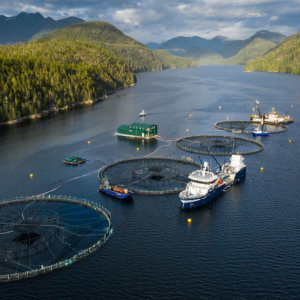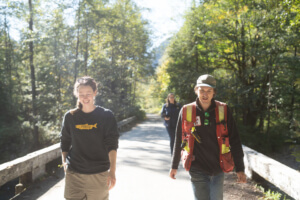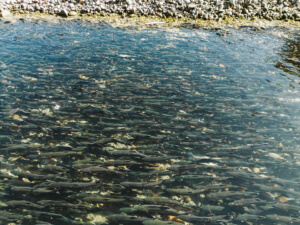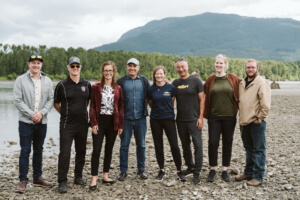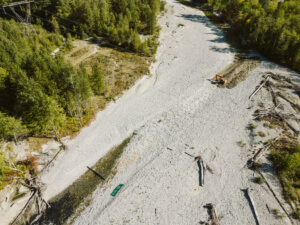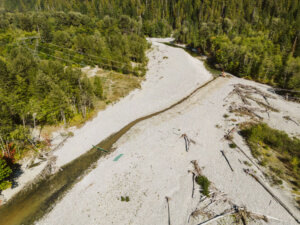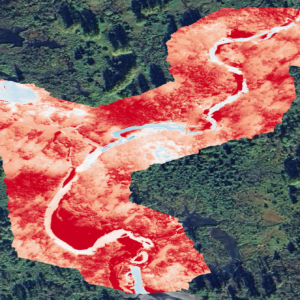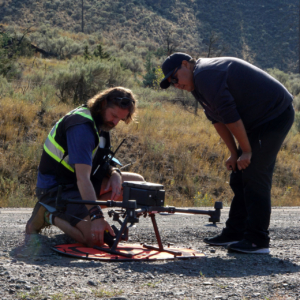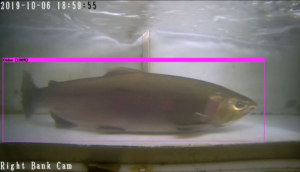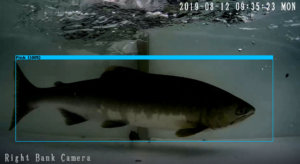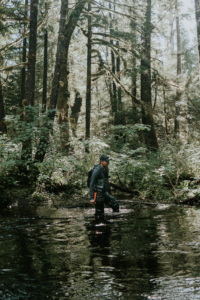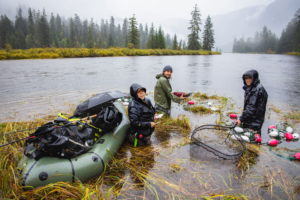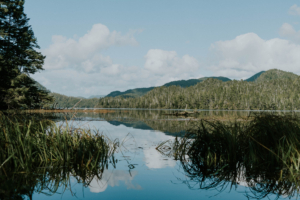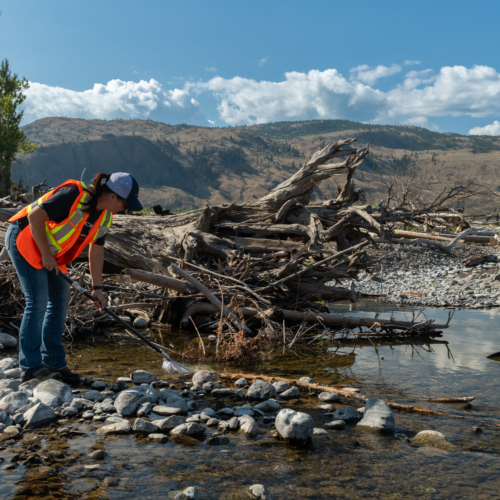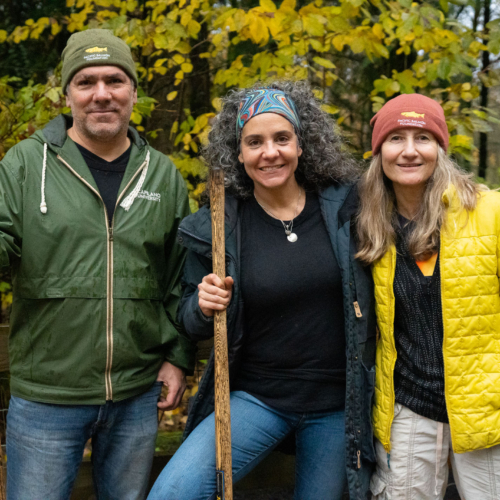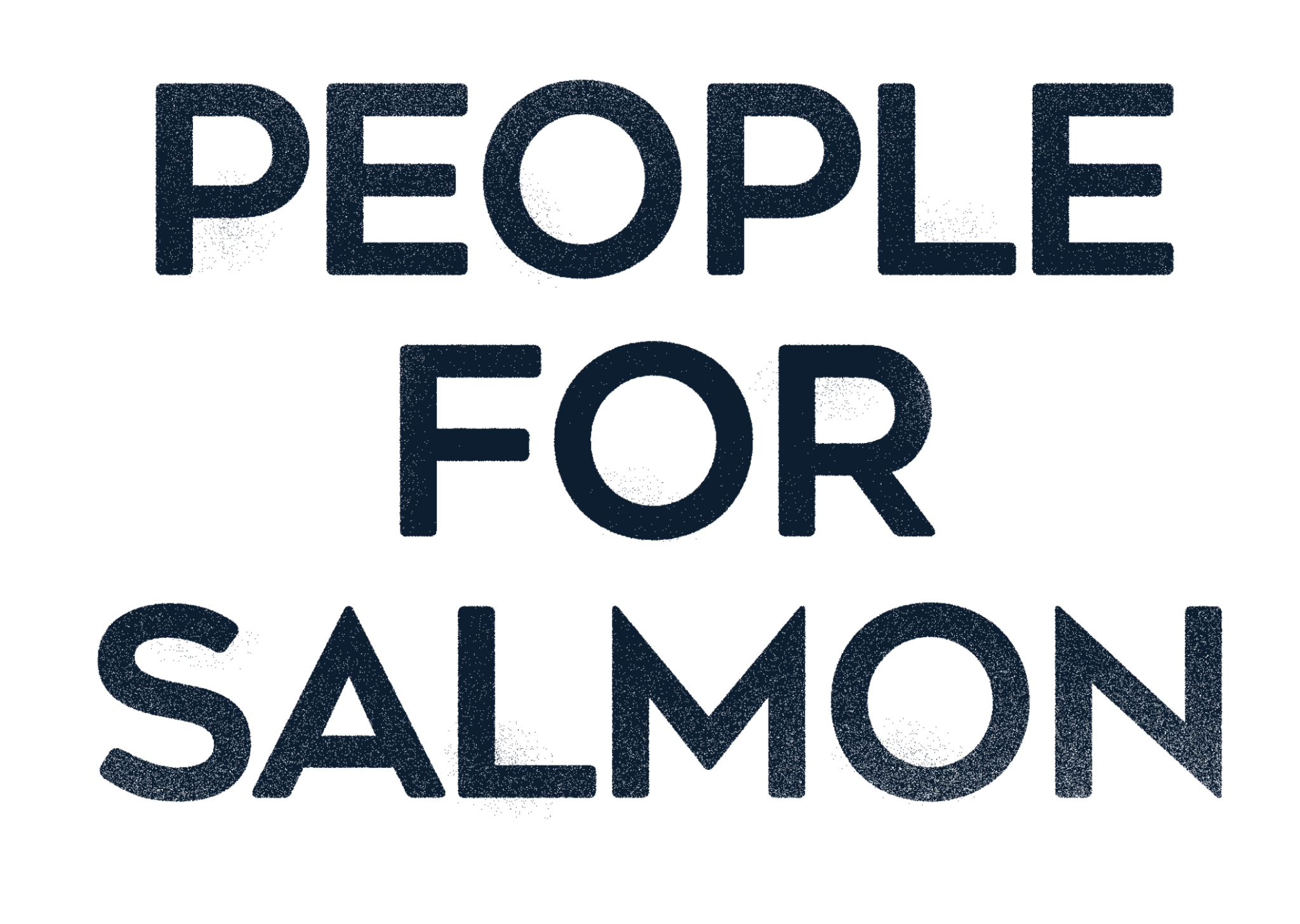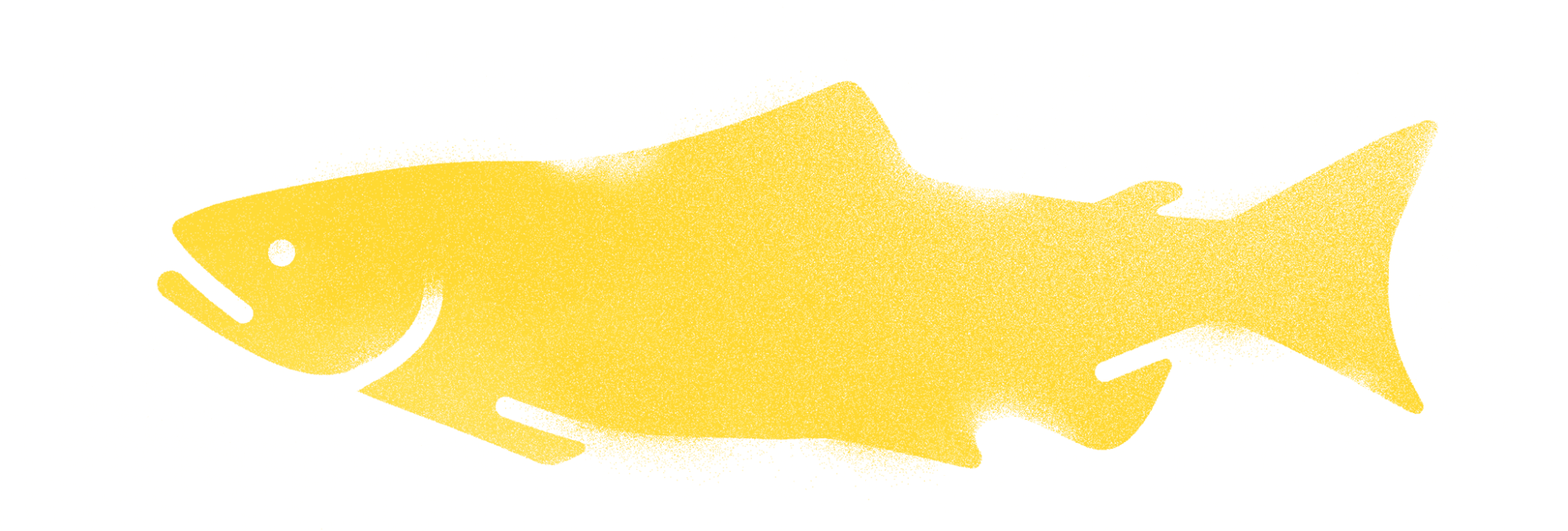President’s Message
2023: Think like a fish
From stream to sea, Pacific salmon face complex and compounding challenges along their elaborate migration journey.
From juveniles embarking on their migration to sea to adult spawners returning to lay eggs and everything in between, the Pacific Salmon Foundation (PSF) asks: What do salmon need at each stage of their life cycle to be healthy and abundant now and in the future?
In 2023, through partnerships with all members of the salmon community, PSF stepped up to support salmon in distress, offer innovative solutions to foster a resilient future for salmon, and provide thoughtful leadership on high-profile salmon issues.
We also saw undeniable evidence of new challenges salmon are up against. Record droughts hit watersheds hard and persisted into 2024. Paired with historically low snowpack, the message is clear: salmon are on the frontlines of climate change.
Yet we know that salmon are resilient. When we all come together, we can help salmon overcome these challenges.
We are proud to share highlights from 2023. With partners, we addressed threats like climate change, invasive species, and habitat degradation, informed by our science and data expertise across the salmon life cycle.
Thanks to our generous donors, government partners, and the Pacific Salmon Endowment Fund Society, PSF remains a leader, problem solver, and neutral broker for salmon.
Your support has been instrumental in creating meaningful change for salmon. Together, we will continue driving a positive impact in 2024.
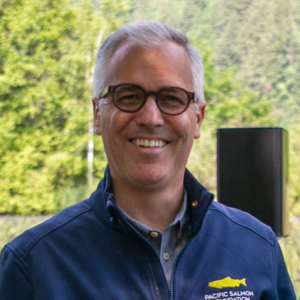 Michael Meneer
Michael Meneer
President and CEO, Pacific Salmon Foundation

PSF BOARD OF DIRECTORS:
Russell Ball, Ross Beaty, Susan Farlinger, Brenda Gaertner, Jeff Giesbrecht, Pamela Goldsmith-Jones, Tim Gudewill, George Iwama, Peter Lister, Murray Ned, Kevin Nugent, Cameron Proctor, Jason Quigley, Gord Sterritt, Shauna Towriss
PSF EMERITUS DIRECTORS:
Ian D. Angus, Robert Gayton, George W. Hungerford, Terry Lanigan, E.L. (Ned) Pottinger, George C. Reifel, Don Swoboda, Rob Waters, Stuart Wolfe, W.J.D. (John) Woodward
ADVISOR:
Rick Bourne
Statement of Operations
Year End, December 31, 2023
Working Across the Salmon Lifecycle
2023 Program Highlights
The life cycle of Pacific salmon spans the smallest streams to the open ocean and everything in between. The Pacific Salmon Foundation works across the salmon life cycle to advance salmon recovery and resilience. Click through the sections below to see examples from 2023 of PSF projects at every stage the salmon life cycle.



Early Life Cycle
Juvenile salmon – growing from eggs to alevin to fry to smolts – must avoid predators, find food, and grow big to prepare for their transition to the ocean.
Expand (+) the three stories below to learn about the early life cycle, featuring research on hatcheries and projects advancing habitat rehabilitation.
What’s next for BC hatcheries?
| Pacific salmon enhancement hatcheries incubate salmon in controlled conditions, then release them into the wild.
Hatcheries in British Columbia release about 250 million juvenile salmon every year. While hatcheries can yield positive impacts, they can also introduce risks to wild salmon. In 2023, PSF completed a review of Pacific salmon hatcheries in British Columbia. The first-of-its-kind since the mid-1990s, the review led to 15 reports and several recommendations to improve hatchery effectiveness and operations. One key recommendation was that some hatcheries might benefit from modifying the timing and size of release practices. PSF has been working closely with DFO’s Salmonid Enhancement Program to implement the recommendations. The British Columbia Salmon Restoration and Innovation Fund – a program from the Government of Canada and the Province of British Columbia – supported the review.
|
|
Tackling Invasive Species
| Aquatic invasive species pose a serious threat to British Columbia’s ecosystems.
In 2023, PSF received a three-year $750,000 grant to help control and manage the spread of European green crabs in the Salish Sea. One of the 10 most unwanted species in the world, the invasive European green crab is making its way into shoreline ecosystems in British Columbia. These invaders are very resilient and out-compete native crabs. Once established, they destroy eelgrass beds that young salmon depend on to survive in the early stages of their lives. Our team carried out early detection monitoring training programs with First Nations communities, aiming to minimize the spread of these non-native crabs. This project is a partnership with Coastal Restoration Society and several coastal First Nations. DFO’s Aquatic Invasive Species Prevention Fund supports this work. |
Reviving Creek Complexity
| Hiłsyaqƛis (Tranquil Creek), about 20 kilometres north of Tofino, was intensely logged in an era when fish and habitat had minimal protections.
Almost a decade ago, ƛaʔuukʷiʔatḥ (Tla-o-qui-aht) First Nation, in partnership with Redd Fish Restoration Society, launched efforts to restore the watershed and recover salmon. In an un-logged watershed, mature trees are a key component of the river processes that create pools, side channels, and otsher habitat areas where young salmon find food, hide from predators, and rest from strong currents. Without large trees and their deep roots, rivers become shallow, fast-moving, and inhospitable to salmon. In 2023, actioning a $88,000 grant from PSF’s Community Salmon Program, ƛaʔuukʷiʔatḥ First Nation and Redd Fish installed one of 10 engineered log jams, using more than 60 full-sized trees, as part of an effort to restore the watershed process that allows salmon to thrive. PSF’s Community Salmon Program granted more than $1.8 million to 163 community-led salmon projects in 2023. |
Community Salmon Program Map
The Community Salmon Program 2021-23 map highlights PSF-funded projects dedicated to salmon conservation across British Columbia and the Yukon. Each marker represents a unique project, showcasing community efforts in stream restoration, habitat enhancement, and educational outreach to sustain salmon populations for future generations.
Mid Life Cycle
Salmon enter the ocean as young adults. The ocean stage of the salmon life cycle is the most difficult to study and thus the least understood. PSF researchers and partners are working to gather new knowledge about this stage in their life cycle.
Click (+) the three stories below to learn more about this research.
Should I stay or should I go?
| Over two years, PSF’s Marine Science team has tagged 329 juvenile Chinook near Comox to track where these fish migrate during their early life in the ocean.
Migration patterns matter because previous research showed that salmon that migrate grow much larger than ‘residents’ that stay in the Strait of Georgia. However, PSF’s initial findings suggest that some Chinook on the east coast of Vancouver Island don’t migrate at all in their first year. A few salmon migrated after winter, but many others stayed in the Strait of Georgia year-round, which has potential implications for management and recovery. The team will continue to monitor the tagged fish until the end of 2026, determining why some salmon stay close to home and whether it affects their survival rates. The British Columbia Salmon Restoration and Innovation Fund supports these efforts. |
What’s a fish to eat?
| High rates of young salmon are dying when they reach the ocean, but we don’t completely understand why.
PSF researchers are studying food availability to determine if starvation is linked to early deaths. In 2023, PSF’s Salmon Health Program tested 600 Chinook salmon in lab trials at varying temperatures, feeding some and starving others. ‘Fit-Chips’, cutting-edge technology that can indicate which stressors individual fish are facing, are being improved based on the study’s findings. In 2024, the team will apply their findings to wild Chinook salmon around Vancouver Island to determine if they’re starving, providing new information on the impacts of climate change and food availability.
The North Family Foundation, MITACS, DFO, and the British Columbia Salmon Restoration and Innovation Fund support this research. |
Research Highlight: Independent Science
| Canada needs an independent scientific body to deliver reliable fisheries science advice, according to a peer-reviewed article co-authored by PSF scientists and published in the Canadian Journal of Fisheries and Aquatic Sciences in 2023.
Using open-net pen salmon farming in B.C. as a case study, the authors highlight that non-scientific interests can influence DFO’s process for providing science advice to decision-makers, and they reiterate calls for an independent fisheries science advisory body. This publication reveals parallels to issues raised a quarter-century ago: that ‘political and bureaucratic interference’ can compromise fisheries science advice in Canada for the sake of industry interests. The work informed the Parliamentary Standing Committee on Fisheries and Oceans’ 2023 study of science advice at DFO, and First Nations and Tribal Councils drew on it in submissions to the open-net pen salmon farm transition consultation process. |
Late Life Cycle
The epic migration of the Pacific salmon life cycle takes place when salmon that are ready to breed, called ‘spawners’, travel thousands of kilometres from the ocean back to their freshwater rivers, streams, and creeks.
The three stories below highlight PSF research, monitoring and emergency response for returning salmon.
Saving tens of thousands of salmon
| British Columbia faced a record-breaking drought in 2023, presenting life-threatening conditions for salmon.
PSF approved more than $330,000 in 2023 through the Climate Emergency Fund to activate immediate on-the-ground drought solutions, preventing mass fish die-offs and helping tens of thousands of salmon overcome migration barriers. At xʔəl̓ilwətaʔɬ (Indian River), PSF’s time-sensitive funding enabled səlilwətaɬ (Tsleil-Waututh Nation) and DFO to restore flows at a dried-out 300-metre-long section of the river that was stranding salmon on their journey upstream. After the restoration effort, more than 18,000 pink salmon successfully migrated past the blockage.
Thank you to the Province of British Columbia, the Pacific Salmon Endowment Fund Society, and generous donors for enabling PSF to respond to climate emergencies. Together, we supported 12 time-sensitive drought response projects in 2023. |
Monitoring climate change using drones
| In the Kitwanga River, a tributary of the Skeena River in northwestern B.C., salmon are increasingly being exposed to unfavourable and potentially lethal conditions during the final stages of their migration upriver to spawn.
Climate change is driving water temperatures above thresholds that are optimal for their survival. But thermal refuges – cool water areas where groundwater pools in rivers – can offer salmon relief from surrounding high water temperatures. The Gitanyow Fisheries Authority (GFA) is working with PSF’s Salmon Watersheds Program to identify these naturally-occurring areas in the Kitwanga River. Using drones with infrared cameras, the GFA, PSF, and BCIT surveyed large areas of the river in August 2023 and plan to repeat surveys in 2024. PSF also worked with the Secwépemc Fisheries Commission in 2023 to survey the Deadman River in Interior B.C. Ultimately, identifying thermal refuges will inform habitat protection opportunities, The British Columbia Salmon Restoration and Innovation Fund and MITACS support this work. |
Counting salmon with AI
| Decision-makers need access to timely information on the abundance of spawning salmon to make informed decisions about their conservation and management.
However, collecting these data can be expensive and labour-intensive – making it difficult to track salmon returns in real-time. Artificial intelligence (AI) can help. PSF’s Salmon Watersheds Program partnered with First Nations organizations, Wild Salmon Center, DFO, and Simon Fraser University to develop AI tools that automatically identify and count salmon from video and sonar data collected at fish fences or weirs. In 2023, AI tools labelled millions of images and trained our models to accurately read video and sonar data. Early results show that they match human performance in a fraction of the time. These AI tools will save fisheries staff hundreds to thousands of hours, freeing up their time to focus on other stewardship efforts. Over the next two years, PSF will continue to deploy and scale up this innovative AI technology. Partners include the Gitanyow, Gitga’at, Haida, Heiltsuk, Kitasoo Xai’xais, Nuxalk, Taku River Tlingit, and Wuikinuxv First Nations, and the Skeena Fisheries Commission. The British Columbia Salmon Restoration and Innovation Fund, RBC Tech for Nature, and MITACS support these efforts. |
The Path Forward
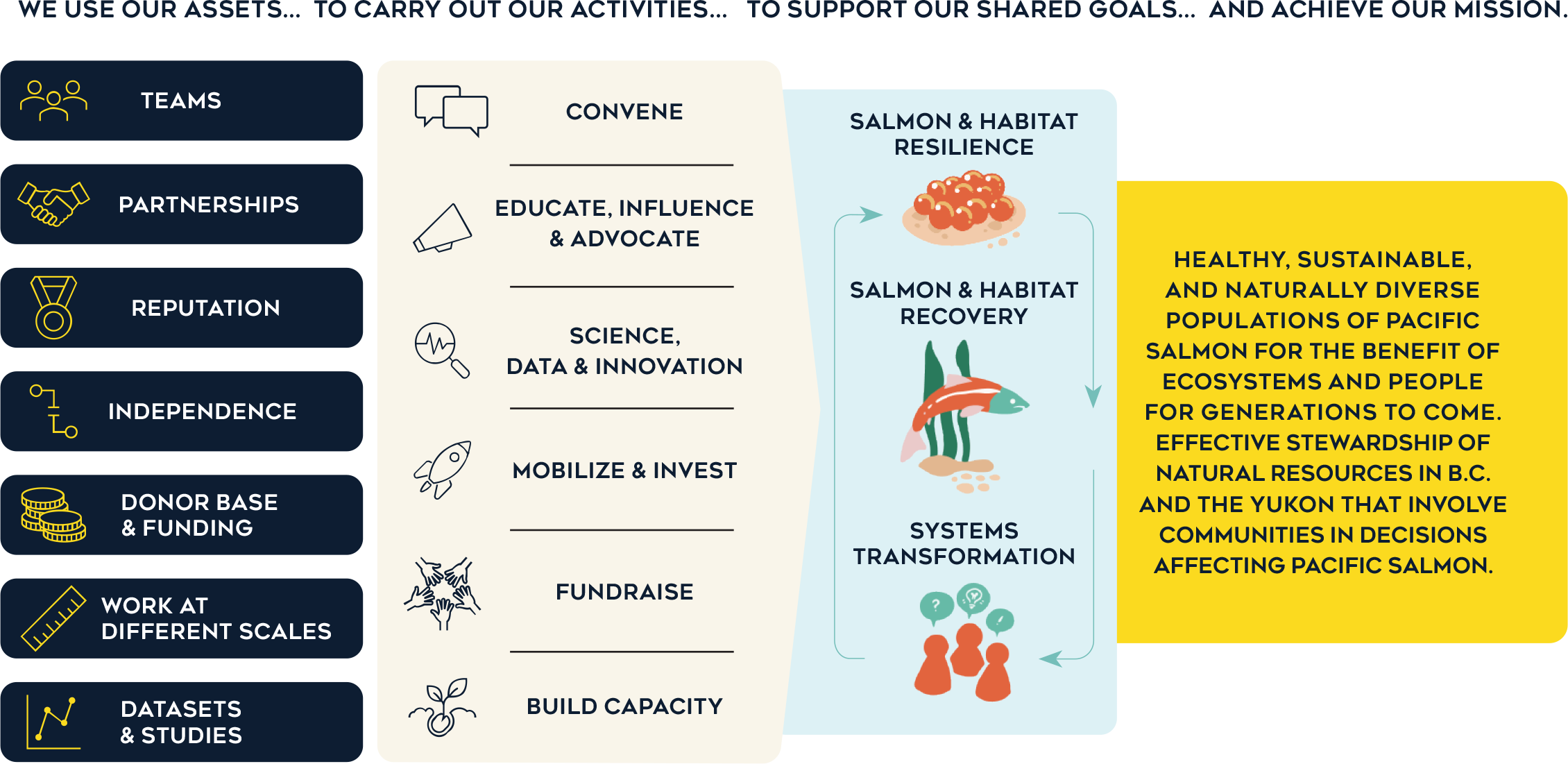
Transforming the salmon system
When it comes to Pacific salmon, times have changed.
The existing salmon management system was established in times of salmon abundance and stability. That is no longer the case.
In the face of climate change, habitat degradation, pollutants, and disease, salmon face many complex challenges. Currently, there is no unified strategy to address these factors.
That’s why PSF and the First Nations Fisheries Council (FNFC) released a report in 2023 titled ‘A Pathway to a Made-in-B.C. Salmon Recovery Model.’ The report outlines a roadmap to modernize and coordinate collective efforts for salmon recovery in British Columbia.
PSF believes we need a new, collaborative way of tackling big issues together that is built from the ground up instead of top-down.
The new report from PSF and FNFC focuses on lessons learned from the Washington State Salmon Recovery Strategy, founded more than 20 years ago, and incorporates input from hundreds of salmon leaders across the province.
To advance this proposed model, PSF and FNFC will collaborate with government partners, seek funding, and develop an implementation plan.
Key Takeaways:
- The importance of long-term, secure salmon recovery funding.
- The need for strong science and Indigenous knowledge-based recovery plans.
- Developing and implementing projects at the watershed scale is essential.
The Sitka Foundation has generously supported this partnership.
What’s next for PSF?
During the next five years, PSF’s efforts will be focused on leading salmon recovery and resilience in an era of climate change and reconciliation.
Our new strategic plan highlights three priority impact areas: Salmon Recovery, Salmon Resilience, and Systems Transformation.
PSF will work with partners to restore declining populations, prevent future declines, and modernize the ‘salmon management system.’
We will advance existing partnerships, leverage new ones, and support Indigenous leadership to create transformational change for the benefit of Pacific salmon at every scale – from the smallest streams to the open ocean.
With nearly 40 years of experience, PSF is at the forefront of salmon leadership in British Columbia. We will continue levelling up our efforts, mobilizing research and influence, to drive the greatest positive impact for the future of Pacific salmon.
Thank You!
PSF’s efforts in 2023 would not be possible without YOU.
Sincere thanks to:
- 863 new donors, including individuals, companies, and foundations
- Hundreds of sponsors and supporters who raised funds at PSF events
- Thousands of salmon supporters that celebrated Wild Salmon Day and Salmon Spotting
We are all people for salmon.
The Heart of the Fraser River. Photo: Brandon Deepwell
The Heart of the Fraser River. Photo: Brandon Deepwell
Photo: Brandon Deepwell
Sockeye salmon. Photo: Brandon Deepwell
The Fraser River canyon. Photo: Brandon Deepwell
At Bridge Rapids in the Fraser canyon, PSF and partners helped thousands of salmon during unprecdented drought in 2023. Photo: Brandon Deepwell
At Tranquille River near Kamloops, rapid drought response efforts were deployed in 2023. Photo: Peter Olsen
PSF’s inaugral Volunteer Day in 2023 brought together more than 25 salmon supporters to help advance hands-on restoration work. Photo: Linda Aylesworth and John Christie
Photo: Maria Catanzaro
Photo: Jake Dingwall
Photo: Jake Dingwall
Redd Fish Restoration Society is studying kelp habitat on the West Coast of Vancouver Island, supported by PSF’s Community Salmon Program. Photo: Graeme Owsianski
Lorne Underwood, Tsawout First Nation, is helping restore nearshore salmon habitat with PSF’s Marine Science Program. Photo: Brandon Deepwell
Photo: Brandon Deepwell
Photo: Brandon Deepwell
